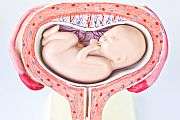(HealthDay)—Cerebral palsy is likely due to multiple prenatal factors, with the contribution of birth defects exceeding that of other major factors, according to a review published in the Sept. 3 issue of the New England Journal of Medicine.
Karin B. Nelson, M.D., from the National Institutes of Health in Bethesda, Md., and Eve Blair, Ph.D., from the Children's National Medical Center in Washington, D.C., discuss the causes of cerebral palsy in singletons born at or after 35 weeks of gestation, who account for two-thirds of newborns with cerebral palsy.
The researchers note that a 2004 report suggested that 70 to 80 percent of cerebral palsy cases were due to prenatal factors and less than 10 percent were due to birth asphyxia. Studies suggest that birth defects are observed more frequently in individuals with cerebral palsy. The contribution of birth defects to cerebral palsy exceeds the contribution of other major factors. Low gestational age at birth is strongly linked to increased risk of cerebral palsy; investigation of the role of birth defects should consider whether the risk is increased through the correlation with early birth. Prenatal factors associated with birth defects and cerebral palsy include marked fetal growth restriction, thrombotic states, placental conditions, and genetic factors.
"Clinical investigations allied with research in genetics and genomics, teratology, and developmental neuroscience are likely to lead to a greater understanding of cerebral palsy and other neurodevelopmental disorders," the authors write.
More information: Full Text (subscription or payment may be required)
Journal information: New England Journal of Medicine
Copyright © 2015 HealthDay. All rights reserved.




















